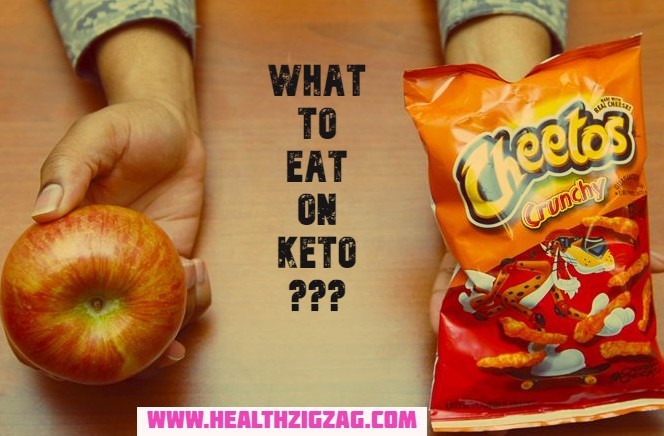
Contents [show]
What is the keto diet? and What can you eat on the keto diet? and What not to eat on keto?
“What is keto?” The keto diet stands for low carbohydrates, but proteins, fat, and vegetables. The goal is for the body to switch from burning carbohydrates and proteins to burning your fat reserves. As a result, you lose weight. Followers of this diet describe the Keto Diet as fierce and heavy. But the kilos and fat edges disappear.
Almost no carbohydrates
Many carbohydrates are not done with this diet. Most carbohydrates must be removed from the menu. The only thing allowed on it is proteins, fat, and vegetables. The traditional ketogenic diet consists of 80% of fats and 20% from proteins and carbohydrates. In the beginning, it is possible that the ratio is 90% and 10%. The purpose of this is to get the body into ketosis as quickly as possible. The fewer carbohydrates, the better.
Ketones end up in your bloodstream because it is a breakdown product of body fat. When there is a high concentration of ketones in your blood, this is also referred to as a ketogenic state.
Read Also: 10 Keto-Friendly, Low Carb Drinks You Can Order At Starbucks
What is ketosis?
Ketosis is part of your metabolism, which is an expensive word for metabolism. Ketose means that your body no longer uses carbohydrates, but fats to make energy out of it. If you get into ketosis, the fat will burn faster. This is not only fat that you get through food but also the fat on your body, such as on your stomach. Ketosis is often the result of an adjusted diet for weight loss, but it also occurs unintentionally in diabetics and pregnant women.
Read Also: 3 healthy low carb ketogenic smoothie list for breakfast
Keto diet – how did it originate?
The keto diet was initially not intended to lose weight at all. In 1929 people with epilepsy were advised to follow this diet. They have no idea how it works, but some patients are less likely to suffer from seizures by following this diet. The diet is generally only applied to children with a difficult-to-treat form of epilepsy. With these children, the medication is insufficient and brain surgery is not an option. The diet works better with children than with adults. This is probably because the brains of young children are still developing and the diet has the most influence.
What should you not eat with a ketogenic diet?
Ultimately, there are always do’s and don’ts with dieting. We list them all briefly. We start with what you are not allowed to eat.
What not to eat on keto?
- Potatoes
- Cereals. So no rice, pasta, oats, wheat, corn, barley, millet, bulgur, sorghum, rice, rye, buckwheat, amaranth, and
- sprouted grains
- pasta
- quinoa
- bread
- breakfast cereals and products made from cereals.
- All sweet products with sugar or aspartame. So soda, juice, shakes, cake, candy
- Low-fat or dietary products. These often contain carbohydrates
- Sauces: these often contain sugar and unwanted fat
- Alcohol: Because of the carbohydrate content, many mixed drinks can throw you out of the ketose
- Almond milk. Raw milk is allowed.
These products are strictly prohibited. You can also put fruit and sugar on the list of prohibited products. A spicy diet.
Read Also: 50 Foods That Are Super Healthy
You may not have these vegetables or beans either:
- Sweet potato, potato, carrots, parsnip
- Artichoke
- Celeriac
- Lentils, chickpeas, peas, kidney beans, kidney beans, soybeans, etc.
- Maize
- Beetroot
- pumpkin
- sugar snaps

what can you eat on the keto diet?
Protein
- fats (fish, nuts and fatty meat)
- lots of green vegetables
- Dairy products
By fats, we didn’t mean a bowl of fries. Because fries are made from potatoes. In fact, you are only allowed to eat the types that are low in starch.
- Lettuce
- Cauliflower
- Zucchini
- Green pepper
- Mushrooms
- Broccoli
- Spinach
- Asparagus
- Cucumber
- Watercress
- Bok choy
- Swiss chard
- Meat
- Fish (herring, salmon)
- Avocado
- Olive oil
- Coconut oil
- Eggs
- Nuts (almonds, cashews, hazelnuts, macadamia nuts, Brazil nuts, peanuts, walnuts)
- Tropical fruit such as pineapple, banana, papaya, mango
Fats! No carbohydrates
Now I hear you thinking? Lose weight by eating fats? It really makes sense. Steak, sausage, salami, pork chop, hamburgers, frikadeller, and meatballs. It’s allowed! If you want yogurt or cottage cheese then you take the fat version. Mayonnaise? No problem.
Olive oil and butter, recipes with a lot of whipped cream, mascarpone or creme fraiche may be placed on your daily menu. Just like cheese, brie, and bacon.
Stop using margarine, sunflower oil, rapeseed oil, soybean oil, grape seed oil. These fats often genetically modified.
You can use nut oil, linseed oil and popcorn seed oil in cold dishes and salads.
Read Also: 10 Ways To Detox Your Body Naturally
Fiber and the keto diet
If you barely get carbohydrates, there may be a shortage of fiber. This can cause a blockage. A fiber supplement can prevent intestinal problems. You will also have to eat a lot of green vegetables. This is because it contains a lot of fibers. Experts advise taking multivitamins with this diet to prevent shortages.
Read Also: 9 Health Benefits Of Avocado for women
Cons of the keto diet
Side effects of ketosis include bad breath, digestive problems and lack of energy. Bad breath is typical of someone who is in ketosis. The lack of energy comes from the fact that fats are more difficult to use for energy than carbohydrates. Read more advantages and disadvantages of the Keto Diet here…
Read Also: 31 Best Foods To Reduce Blood Pressure Naturally
keto diet and diabetes
The diet not only seems beneficial for people with type 2 diabetes because of weight loss. Insulin sensitivity is also increasing. Although more fat is eaten in this diet, the fat composition in the blood also seems to improve and blood pressure can fall.
Read Also: Properties and Health benefits of celery
If you want to follow a ketogenic diet, consultation with your doctor and guidance by a dietitian is always necessary. You probably need less insulin or medication. And a diet is never intended as a diet for the long term, a dietitian can also guide you to adopt a healthy diet after the diet.
Read Also: What is green coffee? Everything you need to know




